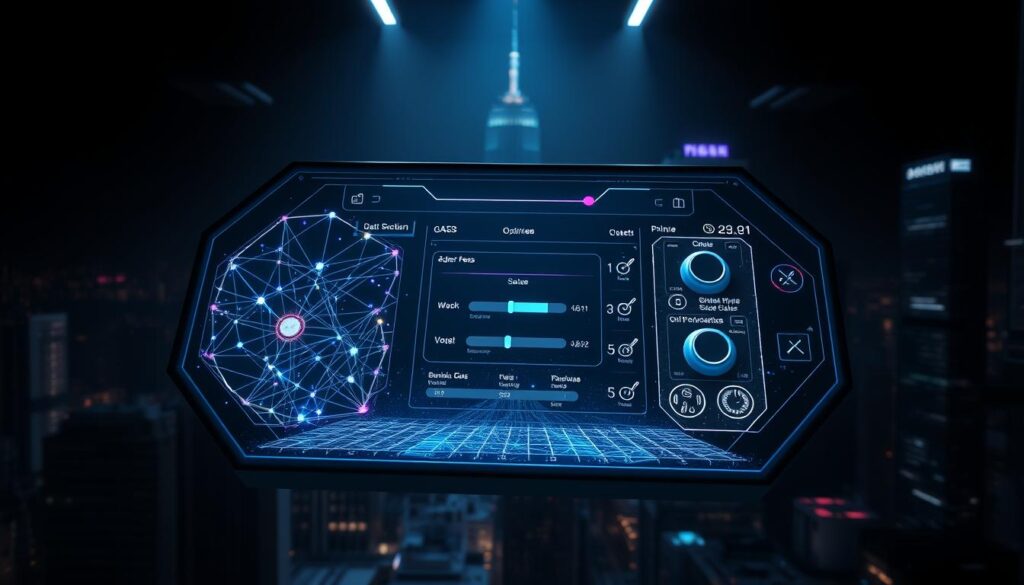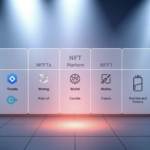Now Reading: Master Artificial Intelligence Blockchain Development Tutorial
- 01
Master Artificial Intelligence Blockchain Development Tutorial
Master Artificial Intelligence Blockchain Development Tutorial

Set the stage for a clear, hands-on guide that links modern AI tools with a decentralized ledger. This intro shows why these fields are converging now and how they complement each other in practical systems.
At its core, a ledger records transactions into blocks that link by cryptographic hashes across a distributed network. This structure boosts transparency and tamper-resistance, so data used in automated workflows stays auditable and reliable.
Real uses include finance, DeFi, NFTs, supply chain tracking, identity, and public voting. Cryptography and consensus protect the chain from tampering and secure the integrity of the data that powers smart contracts and automated decision paths.
Market forecasts show strong growth and rising opportunities for hybrid roles. This guide takes a practical path from basics to building, testing, and iterating with on-chain data in safe test environments.
Key Takeaways
- Understand how a decentralized ledger structures transactions into linked blocks.
- See how cryptography and consensus ensure data integrity for automated systems.
- Explore practical applications across finance, supply chain, and governance.
- Learn a tool-driven, hands-on approach to ship working projects safely.
- Recognize market growth and new hybrid career opportunities in 2025 and beyond.
Beginner’s Guide overview: what blockchain and AI are, and why they’re converging now
This overview explains how shared ledgers and predictive models combine to create verifiable, automated workflows. The goal is a clear starting point so readers can follow the practical learning arc in later sections.
Blockchain at a glance: decentralized, transparent, tamper‑proof ledger
Blockchain is a distributed ledger where participants verify transactions without a central intermediary. This structure provides transparency and immutability, so recorded data stays auditable and tamper-resistant.
AI fundamentals: models, learning, and automation powering smarter systems
Model-based systems learn patterns from data via supervised and unsupervised methods. They automate inference and decision steps across many applications, from finance to logistics.
The 2025 moment: growth, opportunities, and why this tutorial matters
Market signals show rapid growth. Combined offerings are projected to expand strongly, creating new roles such as AI Blockchain Engineer and Smart Contract + AI Auditor.
- Why it matters: Provenance and audit trails help regulators and users assess which data influenced automated decisions.
- Practical arc: learn core concepts, build small components, integrate model output into smart contracts, and test on a network.
- User benefit: reliable automation that documents what happened and why boosts trust and adoption.
Core blockchain principles explained for beginners
Decentralization shifts control from a single operator to many nodes that each hold the same ledger. This setup removes gatekeepers and lets independent participants validate transactions together.
Decentralization and peer interactions across a distributed network
Peers talk directly through a shared network and follow a set of rules to agree on which transactions are valid. Consensus lets global participants join and contribute without relying on a central authority.
Transparency and data integrity on an immutable ledger
Public explorers let anyone inspect addresses and transaction history, creating real transparency across the chain. Immutability means changing one block would force reworking the entire chain under consensus, so retroactive edits are infeasible.
Security basics: cryptography, hashing, blocks, and chains
Cryptographic hashing links blocks and checks data integrity quickly and deterministically. Signatures authenticate who created a transaction, while consensus rules ensure only valid activity is appended.
- Why this matters: immutable proofs reduce disputes and simplify audits in regulated environments.
- Real use: trusted payments, asset transfers, and shared records that need verifiable history.
Under the hood: blocks, nodes, miners, and on-chain data structures
Blocks act like sealed folders that bundle verified transactions and chain together using cryptographic links.
Each block stores a set of transactions capped by size limits. It also includes a reference to the prior block so the whole chain keeps a clear chronological order.
Nodes are the machines that keep copies of the ledger, share new transactions across the network, and validate incoming blocks under agreed rules.
Merkle trees and hash functions
Merkle trees compress many transaction hashes into a single root. That lets a node prove a transaction is in a block without downloading all data.
Hash functions map inputs to fixed-length outputs. Any tweak to a transaction changes its hash, so hashes detect tampering and secure links between blocks.
Linked lists vs DAGs: where scalability enters
Traditional chains are like linked lists: linear, easy to reason about, and good for global order.
DAGs let multiple branches progress at once, giving higher throughput. They need more complex rules to decide finality.
- Tradeoffs: linear chains simplify audits and integrity. DAGs boost performance for heavy processing but add protocol complexity.
- These structures enable practical applications such as audit logs, token transfers, and transparent program execution.
| Element | Role | Benefit | Typical use |
|---|---|---|---|
| Block | Batches transactions | Ordered, verifiable records | Token transfers, audit logs |
| Node | Stores ledger copy | Network resilience | Validation, relay of transactions |
| Merkle Tree | Compresses hashes | Fast proofs without full data | Light clients, quick verification |
| Chain vs DAG | Topology choice | Order vs throughput | Simple systems vs high-volume processing |
Consensus mechanisms you must know
Different consensus methods trade off security, speed, and energy to keep a distributed ledger honest.

Proof of Work: competition and cost
Proof of Work (PoW) makes miners race to find a nonce that produces a target hash. Bitcoin uses SHA-256 and a steady difficulty adjustment.
PoW offers long-running security and resistance to attacks. But it consumes large amounts of power and limits transaction throughput.
Proof of Stake: efficiency and slashing
Proof of Stake (PoS) selects validators by stake size and reputation. Misbehavior can trigger slashing to deter attacks.
Ethereum’s move from PoW to PoS cut energy use and improved throughput for many applications.
DPoS, BFT, and PoA: performance and governance
DPoS elects a small set of block producers for higher speed; EOS and TRON are examples. This boosts performance but adds governance risk.
BFT-style consensus suits permissioned networks like Hyperledger Fabric. It gives deterministic finality and high throughput among known participants.
PoA relies on pre-approved validators for predictable performance in enterprise and consortium systems.
| Consensus | Throughput | Energy | Security model |
|---|---|---|---|
| PoW | Low–moderate | High | Hash power majority |
| PoS | Moderate–high | Low | Stake-weighted validators |
| DPoS | High | Low | Voter-elected producers |
| BFT | Very high | Low | Known validators, quorum |
| PoA | High | Low | Permissioned authorities |
Choosing the right consensus means matching throughput, latency, and energy profile to your use case. Consider risk factors like validator collusion, wealth concentration, and regional centralization of infrastructure.
Design affects user fees, speed, and market adoption. Pick a model that fits your systems, applications, and regulatory needs.
Smart contracts 101: the way code manages transactions and contracts
Programmed contracts execute defined steps when inputs meet preset rules, removing manual steps. Smart contracts are deterministic programs that live on a distributed ledger and enforce agreements without intermediaries.
From conditional logic to autonomous execution
How they run: a user submits a transaction, the contract validates inputs, updates state, and emits events that record the change.
Oracles feed off-chain data into on-chain logic so external prices or sensors can trigger actions. That link keeps contracts useful for real-world workflows.
Example: dynamic lending rates in DeFi using predictions
DeFi platforms like Aave and Uniswap show programmable finance in action. A lending market can adjust interest curves when a model predicts volatility, improving capital efficiency and user experience.
Languages and tools matter. Solidity compiles to bytecode and testing frameworks verify behavior before deployment. Formal verification, audits, and staged testnets build trust and reduce vulnerabilities.
| Aspect | Role | Benefit |
|---|---|---|
| Smart contract | Automates agreements | Faster, auditable transactions |
| Oracle | Delivers external data | Real-world triggers for on-chain logic |
| Testing & verification | Checks correctness | Reduces exploits and builds trust |
Artificial intelligence meets blockchain: trustworthy, auditable AI
Recording model hashes and dataset fingerprints on-chain gives teams a verifiable trail they can rely on during audits. Anchoring artifacts creates a tamper-evident provenance record for training data and models.

On-chain model provenance and data ownership
Store hashes and metadata on a ledger while keeping large binaries off-chain. Use secure references to private storage so ownership stays with creators and datasets remain confidential.
Auditable AI decisions for compliance and transparency
Cryptographic commitments let auditors confirm which model version produced specific outputs without revealing sensitive inputs. Log decisions and rationales to support compliance in finance and healthcare.
Decentralized AI marketplaces and web3 applications
Marketplaces can monetize models under programmable access controls. Tokens and usage-based payments align incentives across contributors, preserving ownership and boosting trust.
- On-chain anchors = tamper-evident lineage
- Commitments enable verifiable audits without data leaks
- Programmable access preserves ownership and creates pay-per-use platforms
Decentralized AI: using blockchain to power secure, peer networks
Moving processing and model updates toward end devices cuts central exposure and raises system resilience.
Why decentralization matters: distributing work across many nodes reduces single points of failure and limits bulk data aggregation. That improves privacy and preserves integrity while letting networks continue after node outages.
Federated learning, edge computing, and contract automation
Federated learning shares model updates, not raw data, so devices train locally and only send gradients or deltas. This keeps private inputs on-device and lets peers contribute without exposing personal records.
Edge computing supports low-latency decisions in IoT and mobility use cases. Local inference helps apps respond fast while lowering bandwidth and central processing needs.
Smart contracts automate incentives, access controls, and revenue sharing. They let a platform reward contributors, enforce usage rules, and record state transitions for auditability.
Real-world momentum and architecture advice
Platforms such as Fetch.ai (agents) and Ocean Protocol (data markets) show traction. The projected market growth to about $20.5B by 2033 highlights rising investment in privacy-first systems.
| Component | Role | Benefit |
|---|---|---|
| Federated learning | Local model updates | Data stays private; contributors keep control |
| Edge processing | Real-time inference | Low latency for critical decisions |
| On-chain coordination | Contracts & records | Auditable incentives and access |
Key industries: finance, supply chain, and healthcare
Major industries now combine secure ledgers with predictive models to cut fraud, speed logistics, and protect patient privacy.
This section highlights practical uses across three high‑impact sectors and the tools teams use to gain real value.
Finance and DeFi: risk, fraud detection, and transparent ledgers
In finance, transparent ledgers help spot wash trading, front‑running, and anomalous transactions fast.
DeFi platforms like Aave and Uniswap pair on‑chain records with analytics to monitor collateral and manage risk in real time.
Result: Faster alerts, auditable policies, and programmatic responses that limit losses.
Supply chain: traceability, anti‑counterfeit, and AI‑driven logistics
Supply chain teams use provenance records to trace goods from origin to shelf and speed recalls.
AI forecasts demand and optimizes routes while shared ledgers preserve a single source of truth across partners.
Outcome: Fewer counterfeit goods, lower waste, and smoother cross‑border coordination.
Healthcare: HIPAA‑aligned data use, diagnostics, and model integrity
Healthcare adopts federated learning so patient data stays local while models improve diagnostics.
Ledger anchors store model fingerprints and version history to prove integrity for clinicians and regulators.
Benefit: Better care decisions with preserved privacy and verifiable model lineage.
| Industry | Main challenge | On‑chain role | AI contribution |
|---|---|---|---|
| Finance | Fraud & risk | Transparent ledger for audits | Real‑time anomaly detection |
| Supply chain | Counterfeits & recalls | Provenance records across partners | Demand forecasting & routing |
| Healthcare | Privacy & model trust | Hashes and metadata for model integrity | Local training and improved diagnostics |
Data, integrity, and ownership: building trust in AI models
Provenance records make it clear which datasets and models shaped a result, and who modified them. Anchoring dataset and model version hashes on a ledger makes tampering detectable and supports reproducible workflows.
Design simple metadata schemas that log collection dates, processing steps, consent, and purpose for downstream use. These labels help teams, auditors, and partners verify why particular data was included.
Express ownership and permissions as on‑chain policies. Smart policy entries record access, transformations, and transactions so every change has an auditable trail.
- Anchor hashes to prove which data and model versions trained a system.
- Use standard metadata to document lineage and consent for compliance checks.
- Log access and policy changes to demonstrate ownership and maintain trust.
Lifecycle rules matter. Versioning, deprecation, and retirement keep integrity in production and speed incident response. Consistent provenance shortens post‑mortems and helps auditors validate what data trained which model and when.
| Goal | Mechanism | Benefit |
|---|---|---|
| Provenance | Anchor hashes on chain | Detect alteration; enable reproducibility |
| Ownership | On‑chain policies & permissions | Clear rights and auditable access logs |
| Compliance | Metadata & lineage records | Faster validation by auditors; regulatory support |
Platforms, tools, and testnets to start building
A focused stack of languages, testnets, and analytics tools speeds iteration and reduces risk when building dApps.

Recommended stack: Solidity for smart contracts, Python for data science, and TensorFlow for model training. Use Google Colab to prototype models and pipelines without local setup.
Testnets, explorers, and analytics
Deploy prototypes to Sepolia to test transactions and contract interactions without spending mainnet ETH. Inspect deployments and events on Etherscan, and analyze protocol activity with Dune and Nansen.
Integrating models and APIs
Wire model outputs into contract-controlled flows using oracles or API endpoints. Integrate inference via the OpenAI API or custom endpoints to feed predictions into on‑chain logic and applications.
- Learn: start Solidity with CryptoZombies and consider bootcamps like Metana or courses on Coursera.
- Monitor: add CI/CD for contracts and data pipelines to keep apps reliable across frequent updates.
- Explore: practical guides such as build a blockchain application can speed your first deploy.
| Area | Tool | Why use it |
|---|---|---|
| On‑chain logic | Solidity | Deterministic contracts, audited behavior |
| Modeling | Python + TensorFlow | Training and exportable models |
| Test & analytics | Sepolia, Etherscan, Dune | Safe testing and real‑world insights |
artificial intelligence blockchain development tutorial
Begin with a reproducible setup: install a Solidity toolchain, a wallet extension (MetaMask), and connect to Sepolia via an RPC provider. Request test ETH from a faucet so you can sign and send transactions without cost.
Step-by-step: from environment setup to your first smart contract
Scaffold a minimal project using Hardhat or Truffle. Compile a simple smart contract that stores a value and emits events on updates.
Write unit tests, add a deploy script that saves addresses and ABIs, and deploy to Sepolia. Verify the contract source on Etherscan and watch transactions and logs as you interact.
Adding AI: model training, inference, and on-chain integration
Train a compact regression or classifier in Python or Colab using TensorFlow or scikit‑learn. Export a lightweight model and serve predictions via a secure API endpoint.
Use an oracle pattern to push signed predictions on-chain. The contract validates the oracle signature and timestamp, then consumes the input deterministically so state changes stay auditable.
Testing on a testnet and iterating with real on-chain data
Validate your end-to-end flow by sending transactions, monitoring events, and reviewing function calls in a block explorer. Use gas profiling and feature flags to tune cost versus responsiveness.
Iterate: adjust model parameters, harden signing, and run repeated scenarios on Sepolia before moving toward mainnet or L2s.
- Essential tools: Hardhat/Truffle, MetaMask, Sepolia, Etherscan, Python (Colab), and an oracle gateway.
- Core checks: unit tests, signature validation, and transaction monitoring on the network.
Hands-on mini project: AI-powered DeFi fee and gas optimizer
Goal: build a small project that predicts ETH gas and uses signed updates to tune fees in a DeFi contract. This example ties live metrics to actionable rules so contracts react to real conditions.

Fetch on-chain data, predict gas prices, and surface insights
Ingest recent blocks and pending transactions from the Etherscan API or a node provider to form a training dataset.
Engineer features such as block timestamps, base fee, and priority fee distributions. Train a simple time-series or regression model in Python and benchmark its mean absolute error against naive baselines.
Integrate predictions into a smart contract for dynamic fees
Design a contract that reads oracle-posted predictions and adjusts fee parameters within guarded bounds. Add signature checks, freshness windows, and rate limits to reduce manipulation risk.
- Run Sepolia tests and simulations that submit transactions under predicted conditions.
- Visualize predictions vs realized gas with a dashboard (Dune or custom UI).
- Refer to an example project guide for starter ideas and deployment steps.
| Step | Action | Outcome |
|---|---|---|
| Data ingest | Pull Etherscan/API metrics | Training dataset for gas forecasting |
| Model | Python time-series/regression | Predictions with MAE benchmarks |
| Contract | Oracle consumer with checks | Adaptive fees, safer transactions |
Security, compliance, and risk management in enterprise systems
Security for on‑chain services starts with mapped threat models that tie keys, oracles, and permissions to concrete mitigation steps. This approach helps teams align technical controls with regulatory expectations.
Enterprises must document controls for key management, access control, and incident response. Add auditable logs that link transactions and data events to owners and policy decisions.
Code assurance is essential. Run static analysis, formal verification where feasible, and external audits. Monitor contracts continuously and plan safe upgrade paths.
- Adopt role‑based permissions and segregation of duties across the network.
- Define risk metrics for oracle dependencies, model drift, liquidity shocks, and transaction failures.
- Keep reproducible builds, signed artifacts, and documented lineage to build trust and speed audits.
| Area | Control | Benefit |
|---|---|---|
| Key management | Hardware wallets + MPC | Reduced single‑point compromise |
| Code assurance | Static analysis & audits | Fewer exploitable defects |
| Consensus | BFT / PoA | Predictable performance for private deployments |
| Governance | RBAC & audit trails | Regulatory readiness and clear accountability |
Scaling considerations: throughput, L2s, and model deployment at the edge
When networks grow, designers must decide which work stays on-chain and which moves off. That choice shapes cost, latency, and the power needed to run systems at scale.
Layer 1 vs Layer 2 tradeoffs for apps and data-heavy interactions
Layer 1 gives the strongest security and canonical history for transactions and audits.
Layer 2 rollups batch many transactions to raise throughput and cut fees while anchoring finality to Layer 1. Use rollups when apps need high-volume processing but still require on-chain proof.
Edge inference for low-latency decisions in IoT and smart cities
Push time-sensitive inference to the edge so devices respond quickly without waiting for network confirmation.
Federated learning and on-device models let teams share updates, not raw data, reducing bandwidth and preserving privacy. Record outcome hashes on-chain to keep an auditable trail.
Operational patterns include partitioning data, placing heavy processing off-chain, and syncing compact proofs back to the ledger to preserve integrity.
Platform fit matters: choose platforms that balance fees, latency, and developer ergonomics for your use case.
| Option | Strength | Best use |
|---|---|---|
| Layer 1 | Security & finality | Auditable records and legal proofs |
| Layer 2 / Rollups | Throughput & low fees | High-volume apps with periodic anchoring |
| Edge + Federated | Low latency & privacy | IoT, smart cities, real-time control |
Career paths and learning roadmap for U.S. beginners
Start your U.S. career path by mapping practical roles, key skills, and a staged learning plan that employers value. This section shows typical roles, salary ranges, and a compact path to build a market-ready portfolio.
Key roles and what they do
AI Blockchain Engineer: builds AI-enabled dApps, connects model outputs to contracts, and manages oracles. Typical U.S. pay: $120K–$180K.
Smart Contract + AI Auditor: reviews contracts, tests model integration, and runs ML-based checks. Typical U.S. pay: $90K–$140K.
Decentralized Product Manager: defines product requirements, coordinates engineering and data teams, and measures impact. Typical U.S. pay: $100K–$150K.
Staged learning plan and core tools
Follow a simple sequence: learn Solidity basics, then Python for data, then ML fundamentals using Colab notebooks. Practice on Ethereum testnets and use the OpenAI API for prototyping inference flows.
- Begin: CryptoZombies for Solidity and Metana bootcamps for applied training.
- Study: Coursera’s AI-for-Everyone-style courses for ML concepts and product thinking.
- Practice: Google Colab, Sepolia testnet, and public dashboards to show results.
Portfolio strategy and community
Build three strong projects that highlight integrity, transparency, and measurable impact. Example: a provenance logger, an oracle-backed fee optimizer, and a privacy-preserving data marketplace.
Show code, test results, and on-chain evidence (explorer links, metrics dashboards). Engage in code reviews, open-source contributions, and mentorship channels to accelerate hiring opportunities.
| Focus | Why it matters | Suggested deliverable |
|---|---|---|
| Integrity | Provenance and audit trails inspire trust | Project with anchored hashes and event logs |
| Transparency | Clear data flows simplify audits and adoption | Dashboard showing predictions vs outcomes |
| Impact | Measureable benefits drive product adoption | Case study with metrics and cost/benefit analysis |
Where this space is headed next: growth, opportunities, and how to stay ahead
Projected market shifts are clear: the combined AI‑anchored market could approach ~$20.5B by 2033 while the broader blockchain sector heads toward ~$469B by 2030. This growth means more hiring, product roadmaps, and investor focus in web3 ecosystems.
Breakout opportunities center on verifiable provenance, edge inference for low‑latency apps, and marketplaces that let data and models trade under programmatic rules. These applications create new value for users and for teams that can ship auditable systems.
Stay ahead by learning continuously, tracking standards, and experimenting with emerging web3 primitives. Join open‑source projects and hackathons, align designs to privacy and compliance, then prototype, measure user outcomes, and iterate to turn ideas into durable products.















